Search Results for Tag: Greenpeace
The Arctic on the UN agenda
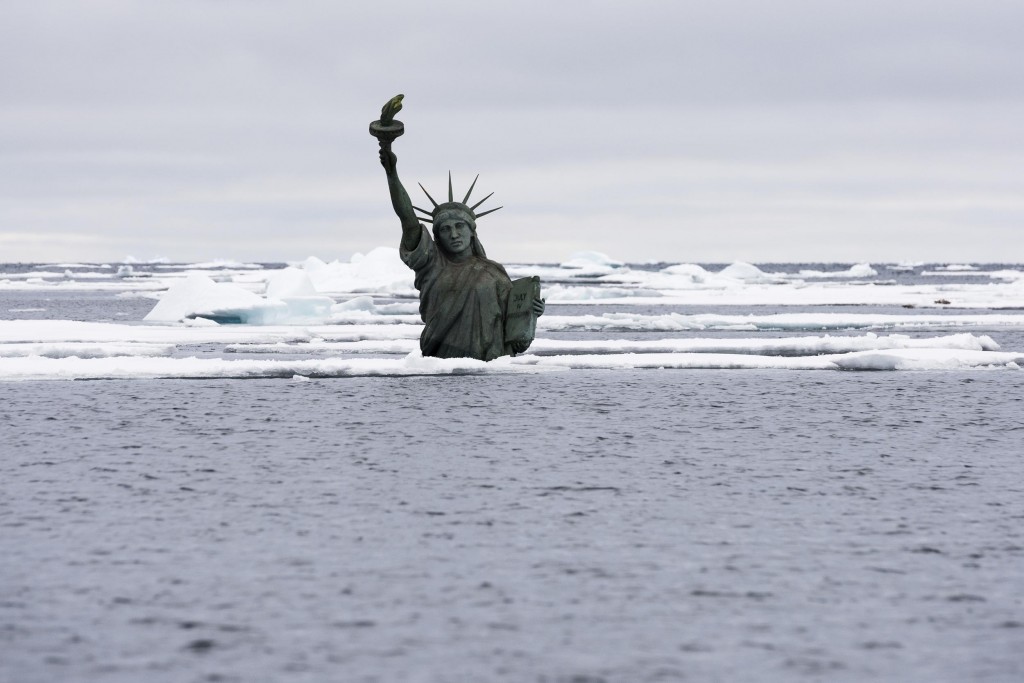
US icon sinking in melting ice? The photo was taken in the Arctic Ocean northwest of Svalbard the 7th of September 2014.
(Christian Auslund / Greenpeace)
To those of us who deal with the Arctic on a regular basis, the significance of the melting ice for the UN climate negotiations and vice versa is abundantly clear. But not everybody understands all the connections. A major media event like this week’s New York climate summit hosted by the UN Secretary General Ban Ki Moon in person was a fine chance to focus attention on the need to protect the Arctic. Greenpeace made good use of it, handing over a petition with six million signatures just ahead of the big event, and with hundreds of thousands gathered in New York for the Climate March.
It was timely in more ways than one, just as the latest sea ice figures were published to confirm the melting trend.
The petition calls for long-term protection of the Arctic, with the region warming more than twice as fast as the global average and opening the high north to shipping and commercial exploitation. Greenpeace and other groups are calling for a ban on oil exploration, which could endanger the fragile ecosystem. Experts also have safety concerns about increased shipping.
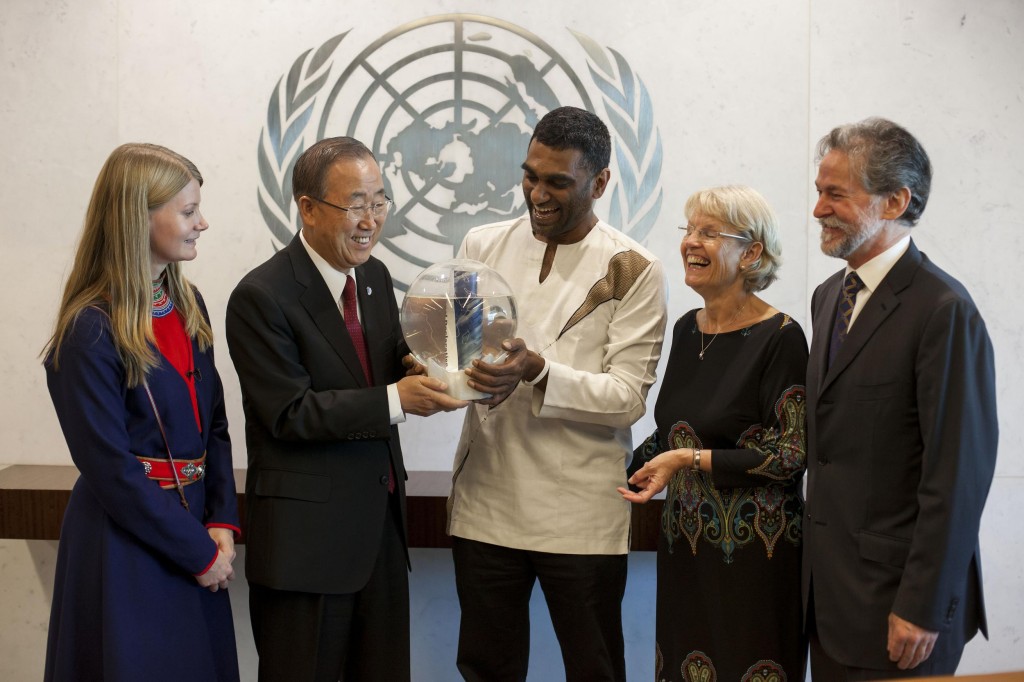
Ban Ki-moon receives the Greenpeace delegation with the petition. The delegation consists of Indigenous rights activist, youth leader and Saami politician Josefina Skerk, Margareta Malmgren-Koller, Greenpeace Senior Political Advisor Neil Hamilton and Greenpeace International Executive Director Kumi Naidoo. Photo: Michael Nagle / Greenpeace
Commercial development versus environment
Earlier this month, a survey showed that 74% of people in 30 countries support the creation of a protected Arctic Sanctuary in the international waters surrounding the North Pole. The study was commissioned by Greenpeace and carried out by Canadian company, RIWI. Around the same time, the Arctic Council, which combines the Arctic states and indigenous peoples’ representatives, currently chaired by Canada, supported the founding of a new business grouping, the Arctic Economic Council. Its aim is to promote the commercial development of the Arctic region. I wrote about this here on the Ice Blog and on the DW website.
Global responsibility for the Arctic
The UN Secretary General accepted the Greenpeace petition saying:
“I receive this as a common commitment toward our common future, protecting our environment, not only in the Arctic, but all over the world.”
Ban Ki-moon said he would consider convening an international summit to discuss the issue of Arctic protection. He also expressed a desire to travel aboard one of the organisation’s campaigning ships in the Arctic in the near future.
Greenpeace Executive Director Kumi Naidoo, who was part of the delegation, said: “The Arctic represents a defining test for those attending the summit in New York”.
He said leaders should bear in mind that concern for the rapid warming of the world was not consistent with planning oil and gas development in the melting Arctic.
The small delegation that met Ban Ki Moon included Indigenous rights activist and Saami politician Josefina Skerk, who last year trekked to the North Pole to declare the top of the world ‘the common heritage of everyone on earth’.
Skerk, a member of the Saami Parliament, said: “We, who want to continue living in the North, are gravely concerned about climate change and the destructive industries that are closing in. My people know and understand the Arctic, and it is changing in a manner, which threatens not just our survival, but the survival of people all over the world.”
Skerk said humans had created the crisis and had to take action to solve it.
“I urge the Arctic countries in particular to take a giant step up and I think the world needs to pay much closer attention to ensure that it happens. They might as well start here in New York.”
From Kiribati to Svalbard and New York
Melting ice especially from the Arctic Greenland ice sheet is raising sea levels around the globe, endangering low-lying areas. At the weekend, the President of Kiribati, Anote Tong, ended a Greenpeace-organized tour of glaciers in Norway’s Svalbard Archipelago. He said the trip to the Arctic ice had made a deep impression on him, which he would share with world leaders at the U.N. climate summit:
“It’s a very fascinating sight. In spite of that, what I feel very deeply is the sense of threat,” Tong said. “If all of that ice would disappear, it would end up eroding our shores.”
Kiribati is a group of 33 coral atolls located about halfway between Hawaii and Australia. Many of its atolls rise just a few feet above sea level.
In last year’s report by the Intergovernmental Panel on Climate Change (IPCC), experts concluded oceans could rise by as much as 1 meter (3.3 feet) by the end of this century if no action is taken to cut the greenhouse gas emissions causing global warming.
“It won’t take a lot of sea level rise to affect our islands,” Tong said. “We are already having problems.”
Sea ice minimum confirms melting trend
The New York summit coincides with the annual announcement of the minimum sea ice for the year, as the summer season comes to an end. The sea ice – in contrast to glaciers on land – does not influence global sea level, but is regarded as a key indicator of how climate change is affecting the region. This year the figure announced by the US National Snow and Ice Data Centre (NSIDC) was 5.01 million square kilometers. The figure is the sixth lowest extent since records began.
The minimum ever recorded at the North Pole was 3.29m sq km in 2012 – and the eight lowest years have been the last eight years.
Ice levels in the Arctic have recovered from their all-time low, but are still on a shrinking trend, said Julienne Stroeve of the National Snow and Ice Data Centre. ”We have been telling this story for a long time, and we are still telling it,” she said.
NSIDC records showed that, this year, ice momentarily dipped below 5million sq km to 4.98m on 16 September, but the official figure is taken from a five day average.
Satellite data shows that one part of the Laptev Sea was completely clear from sea ice for the first time this summer. One of the most important questions for climate scientists is how soon the Arctic will experience its first sea ice-free summer.
Rod Downie, head of WWF UK’s polar programme, said that this year’s new Arctic minimum should prompt new action from the leaders meeting in New York. He stressed the connection between the Arctic and weather conditions in other parts of the world:
“As David Cameron prepares to meet other global leaders at the UN climate change summit in New York, the increased frequency of extreme weather that is predicted for the UK as a result of a warming Arctic should serve as a reminder that we need urgent action now to tackle climate change,” he said.
The summit was a major PR event to draw attention to the need for urgent and substantial climate action. The accompanying protests around the globe show people are not happy with the slow pace of the climate talks and their governments’ efforts to reduce emissions. Of course there was little in the way of concrete pledges. Still, on the whole, I see it as a successful step on the way to a new climate agreement because it has put the spotlight on climate change at a time where international conflicts are dominating the news agenda.
More commentary on the summit from me here:
World leaders must act as climate takes centre stage
All-star gala puts climate back on the agenda
World Cup Champs for Arctic Climate?
Chancellor Merkel is on her way from the World Cup Final in Brazil to Berlin, where she will address the Petersberg Climate Dialogue. This is an informal but influential meeting of 35 international ministers, co-chaired by Peru, the host of the next world climate conference this December. UNFCCC chief Figueres is also in attendance, hoping progress will be made towards a successful Peru conference and a new world climate agreement to be signed in Paris in 2015. Yes, it is a kind of conference to prepare the conference to prepare the conference…. but every little step helps. As I wrote here and on the DW website during the last round of preparatory talks in Bonn, things are looking more positive than they once did, with the big players USA and China finally coming into the game. Here’s hoping Frau Merkel can bring some of the energy and enthusiasm from the World Cup into the “Petersberg Dialogue” (initiated on the Petersberg here in Bonn, but since moved to Berlin) and the climate process. I interviewed Martin Kaiser, the climate policy chief at Greenpeace about the current state of play. You can read the interview here. But I also talked to him about that key ice blog issue, the relevance of all this to the Arctic.
Here is his response, if you would like to listen: For those who prefer a read, this is what Martin Kaiser had to say about the UN climate process and the Arctic:
“If we want to limit the ice melt in the Arctic, we have to address the issue of climate change. If we don’t manage to get countries like China and the US, to drastically reduce emissions from burning coal and oil, the ice melt is unstoppable. The Arctic is one of the places in the world where you can see the drastic changes caused by global warming in a most visible way. We expect a historic minimum ice melt this September, and this will give a clear warning when heads of state are going to meet in New York at around the same time.
It’s quite contradictory that oil companies are going to the Arctic to drill for more fossil energy which will fuel global warming even more. This needs to stop. That’s why Greenpeace is calling for a sanctuary in the Arctic which prohibits commercial exploitation of the region.
(Ice Blogger: How does that look in the countries with Arctic regions?)
If we look at Canada – It has one of the most regressive climate policies in place, Prime minister Harper is one of the worst climate deniers, and Canada is investing a lot into tar sands in the west of the country – a business model that is not sustainable. Russia’s business model is based on the export of oil and gas, so it is problematic to talk to Russia about the protection of the Arctic at the moment. Greenpeace has had experience of how they prioritize this business model over preserving the rare ecosystem. There are more countries like China and India coming in to the Arctic, and wanting to get a share of the resources extraction, and that is a worrying sign. Instead of protecting the Arctic, it’s opening like the Wild North for the big corporates investing into oil and gas. That means we have to have a political process which clearly determines a sanctuary in the Arctic and limits commercial exploitation of it.
Finland has been quite progressive so far to move forward the idea of a sanctuary in the Arctic. We hope that rich countries like Norway or also Iceland will join that group. But that’s a long way to go.”
Arctic oil: confrontations ahead?
The first oil from the controversial Prirazlomnaya offshore Arctic oil platform is on its way to Rotterdam. This, you will remember, was the oil rig where the Greenpeace “Arctic 30” were arrested by Russian forces last September during a protest. The Greenpeace ship Rainbow Warrior III is on its way to meet the tanker, the “Mikhail Ulyanov”, and protest against Arctic oil drilling. (The Greenpeace icebreaker Arctic Sunrise remains in the custody of the Russian Investigative committee, over six months after the action and four months since an official amnesty was adopted).
This oil transport marks the first ever shipment of Arctic offshore oil. Interestingly, it has been bought by the French oil concern Total SA. I remember the furore when the chief executive of that very company Christophe de Margerie, ruled out drilling in the Arctic in 2012 out of concern about the effect of a possible spill. Hm. Looks like it’s OK to profit from the oil as long as somebody else takes the risk. Although I seem to remember at the time that worry about the negative impact a spill in the sensitive ecosystems of the remote Arctic would have on the image of the industry as a whole played a role in the decision.
Greenpeace Captain Peter Willcox, a member of the ‘Arctic 30’ who was imprisoned in Russia for over two months after the protest at Gazprom’s Prirazlomnaya platform in the Pechora Sea last year, is at the helm of the Rainbow Warrior III. The organization is not saying much about what form the protest will take as yet. But presumably the risks of a drastic response like last year’s Russian crack-down are minimal in the North Sea. As far as the culture of dealing with protest in the Arctic is concerned however, a recent announcement by President Putin gives little reason for optimism. On April 23rd, the Barents Observer carried a worrying report headlined “Putin arms Arctic drillers” on a meeting between Putin and his top national security aides. It says Putin highlighted the need for an enhanced security presence in Russian Arctic territories to protect oil production facilities, loading terminals and pipelines “against terrorists and other potential threats”.
The same day Putin signed amendments in a federal law on the protection of oil and gas objects and infrastructure. It gives Russian oil companies the right to establish their own protection units. The Barents Observer quotes the newspaper Rossiskaya Gazeta as suggesting the companies might eventually hire “thousands of well-armed people, equipped with automatic weapons, vehicles, vessels and aircraft”, mostly former military personnel, police officers and special forces agents. Even if that proves to be slightly exaggerated: the thought of corporate armed units having the law in their own hands to squash anything that looks like opposition to Arctic development is a nightmare.
“This week’s Arctic speech from the Russian leader has a scope which goes far beyond imagined threats from potential terrorists. It also includes a major element of heightened inter-state tensions”, according to the Barents Observer. Given the current climate against the background of the ongoing Ukraine conflict, I have to share that concern. With the Russian leader stepping up the country’s military presence in the Arctic arguing that there is an “increasing conflict of interest between the Arctic coastal states” and that “the situation in the world is fraught with new risks and challenges to Russian national interests”, it is hard to be optimistic about the prospects for an Arctic future free of confrontation.
Santa in distress in a melting Arctic
As I was floating around our local swimming pool to the sound of “Rudolph the red-nosed reindeer” last night, the thought of reindeer in water took my thoughts up north. Poor old Santa must be having a worrying time. Snow and sleighs are the basis of his business. If anybody has to be concerned about what climate change is doing to the Arctic, it has to be Santa. His snowy wonderland is melting twice or even three times as fast as the rest of the planet. Reindeer are threatened by climate change, a new report confirms.
Maybe he is already thinking about some alternative transport. Marine animals to get across an increasingly watery north? Walruses? Whales? Dolphins? But he’d have problems putting them out the back to graze while he distributes the presents and sips his sherry. And in the long-term their food sources could be increasingly problematic with ocean acidification threatening so many species. A hi-tech climate-neutral alternative like the solar plane? Not much good at night. And not nearly as much fun as reindeer.
Then come the territorial disputes, with Canada and Russia arguing over who owns the North Pole. Santa would not want to be caught in the crossfire. And landing on rooftops is becoming increasingly hazardous. Does it count as hooliganism?
His Russian partner “Father Frost” (aka Grandfather Frost or Jack) must be getting a bit worried as well. He’s said to be building a giant freezer to keep Siberia cool – powered presumably with oil and gas from the Arctic.
I’m not the only one to be concerned. Greenpeace have come up with a “Save Santa’s Home” campaign, and a whole set of electronic Christmas cards drawing attention to the plight of our jovial white-bearded gift-bringer. And if you haven’t seen Santa’s Message on video, have a look. And remember we British have a tongue-in-cheek kind of sense of humour. CNN missed that, I think, when they broadcast their own story about the video (although it is not without a sliver of its own biting wit). Reporter Jeanne Moos reminds Santa that “An organisation of climate change sceptics” is talking about “recovering Arctic ice”. The “other side” does (in the interests of unbiased journalism no doubt 😉 ? get quoted in the report. Moos talks about “those who believe in global warming” as if the majority who accept the findings of something like 99% of scientists, the UN, the IPCC… belonged to a weird sect.
 Santa, I’m with you and all those who are interested in protecting the Arctic from climate change and pollution. Rudolph, Dancer, Prancer and the rest of you guys – keep up the good work. You make millions of kids (and a lot of grown ups) happy every Christmas. Here’s hoping the world will take some steps in 2014 that will preserve your frozen north home for generations to come.
Santa, I’m with you and all those who are interested in protecting the Arctic from climate change and pollution. Rudolph, Dancer, Prancer and the rest of you guys – keep up the good work. You make millions of kids (and a lot of grown ups) happy every Christmas. Here’s hoping the world will take some steps in 2014 that will preserve your frozen north home for generations to come.
Merry Christmas everybody! The iceblogger will be back in January 2014. Keep your eye out for the odd tweet @iceblogger
Why conferences like Warsaw won’t save the Arctic!
No wonder the ngos walked out in disgust. The latest UN climate conference has strengthened my feeling that these mega-events are not going to lead to the emissions reductions we need to protect the polar ice and the world climate.
Typhoon Haiyan and its devasting effects on the Philippines was a fine warning of what the world could be facing if we are not able to put the brakes on climate change. The newest IPCC report provides impressive evidence of the need for swift and effective action to combat climate change. Otherwise, the world will have to cope with more frequent and severe extreme weather events, rising seas, floods and droughts. The World Bank and the UN have set the alarm bells ringing. We have to reduce emissions by around 85% by 2050 to keep global temperature rise to the two-degree Celsius limit. The International Energy Agency says that would mean leaving 80% of our remaining fossil fuels in the ground.
Climate sinners hosting
Unfortunately the track laid out for the conference in Poland was heading in another direction from the start. Fossil energy providers and huge energy consumers like the steel and car industry were sponsoring the event. The host country Poland is and plans to remain a coal country. So far, Warsaw has blocked more ambitious emissions targets in the EU. The fact that a coal summit was held in Poland during the climate negotiations was clearly demonstrative – and verges on the cynical. The sacking of the Polish environment minister who was chairing the talks shows a lack of respect for the meeting and the issue of climate change itself.
Climate politics: no leadership in sight
But the failure of the conference was not just Poland’s fault. CO2 emissions are continuing to rise globally, and the conference delegates did not have much in their luggage to do anything about it. It was far too little in the way of commitment to binding emissions reductions or to creating an effective and well-funded compensation mechanism for developing countries. The poorest countries, which are already struggling to cope with unpredictable climate patterns, droughts and flooding, went home disappointed and frustrated – once again.
The EU was unable to agree on tighter emissions targets ahead of the conference. Germany, long considered a leader in the field, is currently putting the brakes on its own renewable energy revolution by shifting financial incentives. Japan, Canada and Australia, all took a step backwards. And in spite of some progress at home, the major emitters China and the USA were unlikely to make any substantial announcements.
No progress on a new climate agreement
The Warsaw conference was supposed to come up with an effective timetable to lead to a new international climate agreement, scheduled to be set up in 2015 and implemented in 2020. Instead, it seems countries are playing for time and putting off any binding commitments. The vague document agreed at the very last minute contains no firm deadline for emissions pledges – which will not be binding anyway. The window of opportunity is rapidly closing. Decades of negotiations have produced little in the way of results. Every year without a decrease in greenhouse gas emissions reduces the prospect of keeping to the “two degree” target. Existing pledges fall way short of what is required. The “business as usual” trajectory is heading for a temperature rise of at least four degrees Celsius.
Once more, the UN climate conference has shown its inability to protect the world from the dangers of rapidly progressing climate change. Aside from the annual mega-meetings, which are in danger of disintegrating into mere token events, there are still signs of hope. China, for instance, is making considerable progress on energy issues, although the country refuses to accept internationally binding targets. Climate protection has to become part of daily politics and business in industrialised and emerging countries. Politicians must be prepared to abandon short-term advantages in favour of a long-term perspective, which would guarantee the future for coming generations through a sustainable low-carbon economy. The means turning away from oil and coal, developing renewable energies, ensuring a high price for carbon and providing adequate finance to protect developing nations from climate change caused by past emissions of the industrialised world.








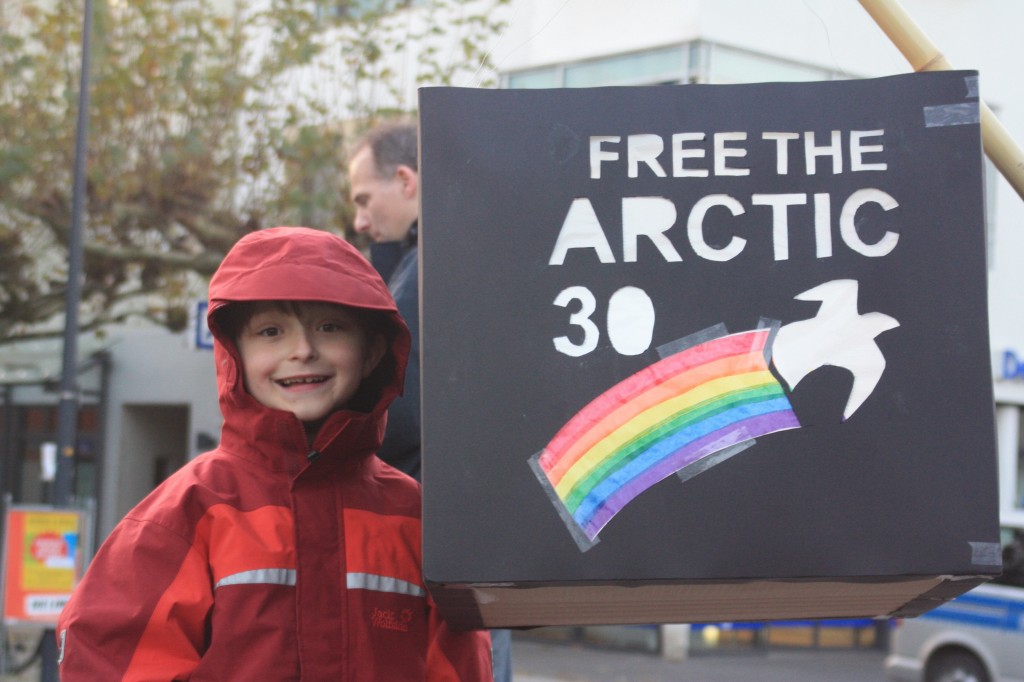
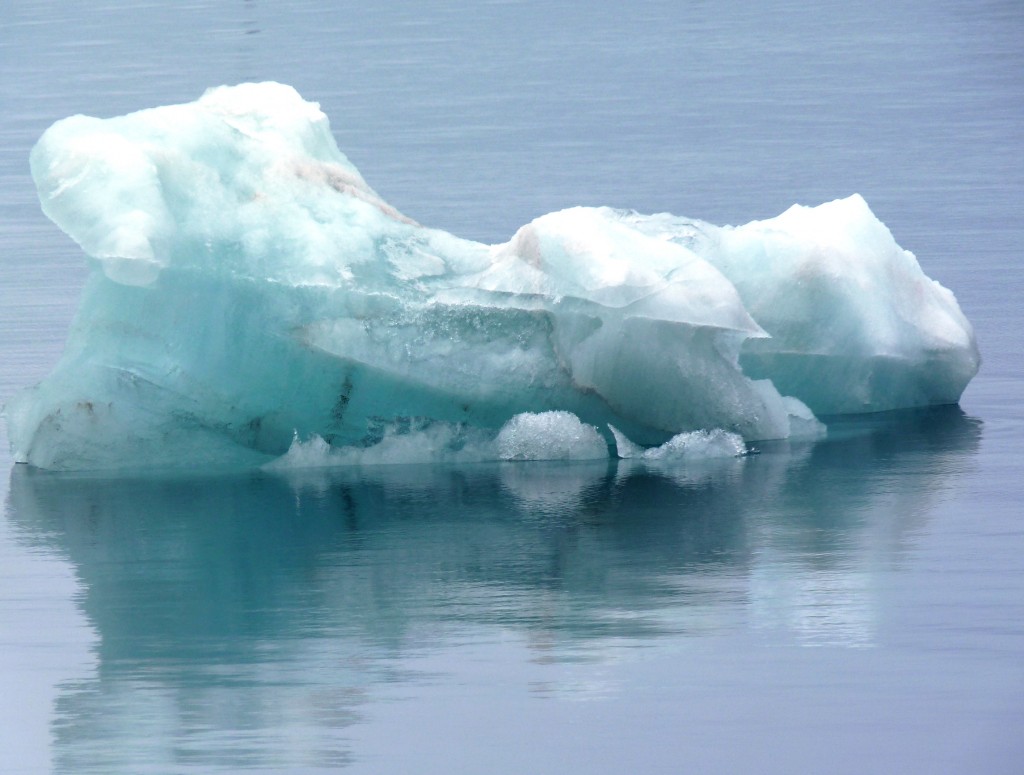
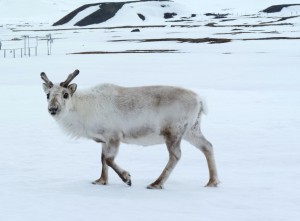
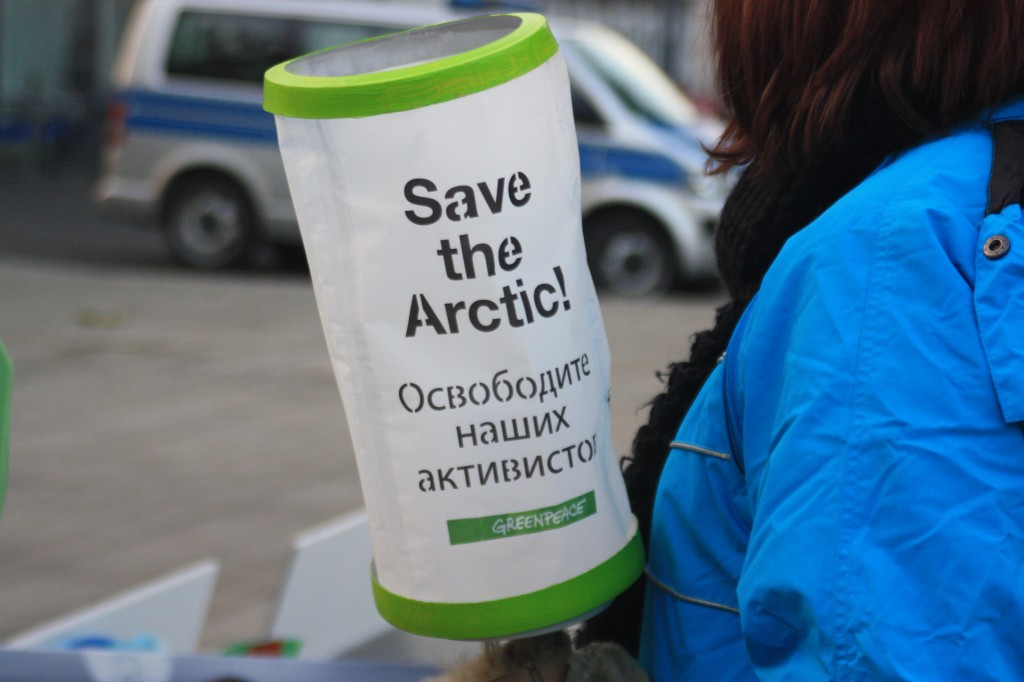

















Feedback